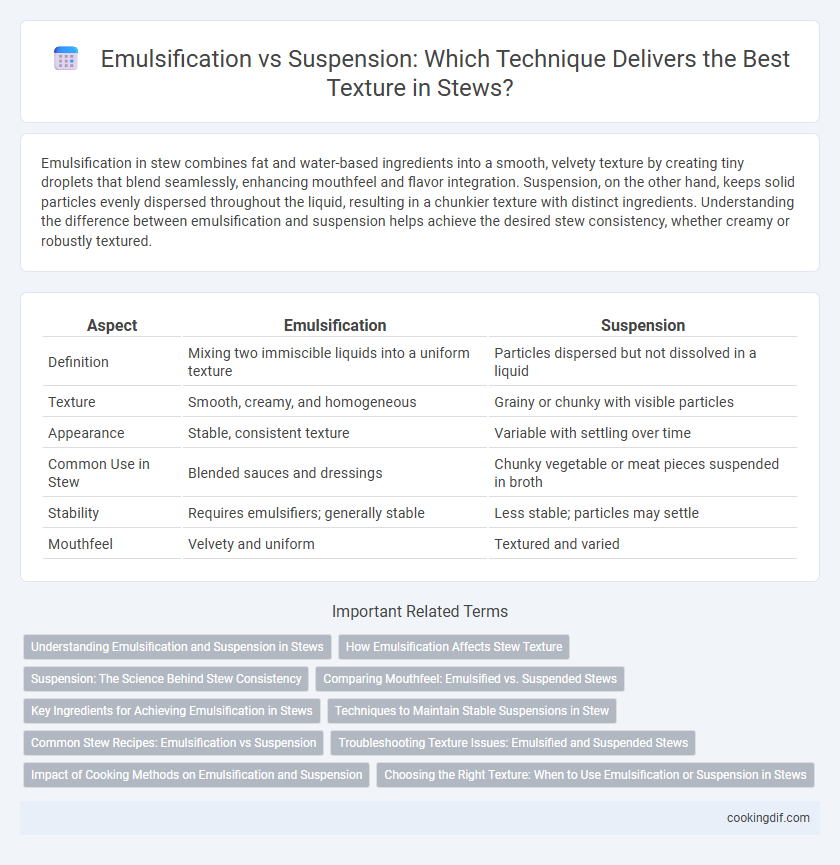Emulsification in stew combines fat and water-based ingredients into a smooth, velvety texture by creating tiny droplets that blend seamlessly, enhancing mouthfeel and flavor integration. Suspension, on the other hand, keeps solid particles evenly dispersed throughout the liquid, resulting in a chunkier texture with distinct ingredients. Understanding the difference between emulsification and suspension helps achieve the desired stew consistency, whether creamy or robustly textured.
Table of Comparison
| Aspect | Emulsification | Suspension |
|---|---|---|
| Definition | Mixing two immiscible liquids into a uniform texture | Particles dispersed but not dissolved in a liquid |
| Texture | Smooth, creamy, and homogeneous | Grainy or chunky with visible particles |
| Appearance | Stable, consistent texture | Variable with settling over time |
| Common Use in Stew | Blended sauces and dressings | Chunky vegetable or meat pieces suspended in broth |
| Stability | Requires emulsifiers; generally stable | Less stable; particles may settle |
| Mouthfeel | Velvety and uniform | Textured and varied |
Understanding Emulsification and Suspension in Stews
Emulsification in stews occurs when fat droplets are finely dispersed throughout the liquid, creating a smooth, cohesive texture that enhances mouthfeel and flavor integration. Suspension involves solid particles or ingredients being evenly distributed but not dissolved, resulting in a chunkier texture with distinct components. Understanding these processes helps cooks control stew consistency, balancing richness from emulsified fats with the hearty bite of suspended solids.
How Emulsification Affects Stew Texture
Emulsification in stew creates a smooth, velvety texture by evenly distributing fat and liquid components, preventing oil separation and enhancing mouthfeel. This process stabilizes the mixture, resulting in a consistent and rich broth that coats ingredients thoroughly. In contrast, suspensions yield a more uneven texture with visible fat droplets, leading to a less integrated and grainier stew experience.
Suspension: The Science Behind Stew Consistency
Suspension in stew involves evenly distributing solid ingredients like meat and vegetables throughout the liquid without fully blending them, creating a rich, chunkier texture. This occurs when starch granules or fat droplets remain dispersed rather than forming a stable emulsion, maintaining distinct ingredient pieces that contribute to mouthfeel and visual appeal. Understanding suspension dynamics helps chefs control stew consistency, ensuring optimal flavor release and satisfying bite characteristics.
Comparing Mouthfeel: Emulsified vs. Suspended Stews
Emulsified stews deliver a smooth, creamy mouthfeel due to the uniform distribution of fat droplets within the liquid phase, creating a rich and cohesive texture. Suspended stews feature distinct particles of meat, vegetables, and fat suspended in broth, providing a chunky, varied mouthfeel with noticeable texture contrasts. The emulsification process enhances flavor integration and silkiness, while suspension maintains a robust and hearty bite sensation.
Key Ingredients for Achieving Emulsification in Stews
Key ingredients for achieving emulsification in stews include fats like butter or oil combined with proteins such as egg yolks or gelatin, which act as emulsifiers to stabilize the mixture. Lecithin-rich components, like mustard or soy lecithin, enhance the emulsion by reducing surface tension between liquids. Properly whisking or slow simmering ensures the dispersion of fat droplets, creating a smooth, velvety texture distinct from the coarse consistency of suspensions.
Techniques to Maintain Stable Suspensions in Stew
Maintaining stable suspensions in stew relies on techniques such as continuous stirring and gradual incorporation of ingredients to prevent separation of solids and liquids. The use of natural thickeners like flour or cornstarch enhances viscosity, allowing even distribution of particles throughout the broth. Controlling temperature is essential, as consistent moderate heat minimizes ingredient settling and preserves uniform texture.
Common Stew Recipes: Emulsification vs Suspension
Common stew recipes achieve texture through emulsification or suspension techniques, where emulsification creates a smooth, cohesive mixture by blending fats and liquids, resulting in a velvety mouthfeel. Suspension methods keep solid ingredients like vegetables and meat evenly dispersed within the broth, producing a chunky and hearty texture. Understanding these techniques enhances control over the stew's consistency, flavor integration, and overall sensory experience.
Troubleshooting Texture Issues: Emulsified and Suspended Stews
Emulsification in stew creates a smooth, homogeneous texture by evenly dispersing fat droplets within the liquid, while suspension involves solid particles like vegetables or meat remaining dispersed without blending fully. Troubleshooting texture issues requires identifying whether fat separation or ingredient settling is causing inconsistency, which can be corrected by adjusting emulsifying agents such as mustard or lecithin, or by increasing stirring and temperature control to maintain stable suspension. Proper balance of emulsifiers and viscosity ensures a cohesive stew texture, preventing graininess or separation during cooking and serving.
Impact of Cooking Methods on Emulsification and Suspension
Cooking methods significantly influence the emulsification and suspension in stew textures, where slow simmering promotes stable emulsification by gradually blending fats and liquids, enhancing creaminess. High-heat boiling or rapid stirring often disrupts emulsions, creating suspended particles that produce a chunkier, more textured stew. Pressure cooking tenderizes ingredients quickly, but may reduce emulsification stability, resulting in a more separated, suspension-driven consistency.
Choosing the Right Texture: When to Use Emulsification or Suspension in Stews
Emulsification creates a smooth, cohesive texture by blending fat and water-based ingredients into a stable mixture, ideal for creamy, rich stews like a classic French beef bourguignon. Suspension allows solid particles such as herbs, spices, or vegetables to remain dispersed in the liquid, lending a chunkier, rustic texture suited for hearty vegetable or meat stews like traditional Hungarian goulash. Selecting emulsification or suspension depends on the desired mouthfeel and presentation, with emulsification providing a velvety consistency and suspension offering a robust, textured bite.
Emulsification vs suspension for texture Infographic

 cookingdif.com
cookingdif.com